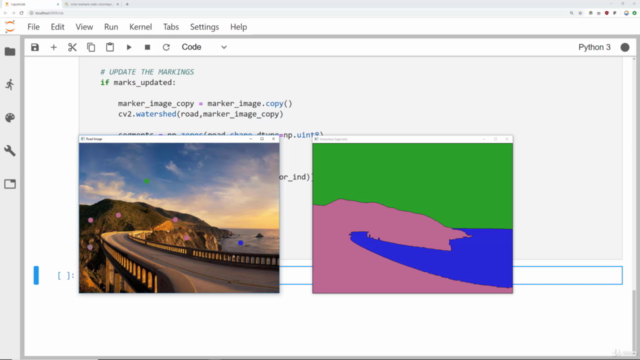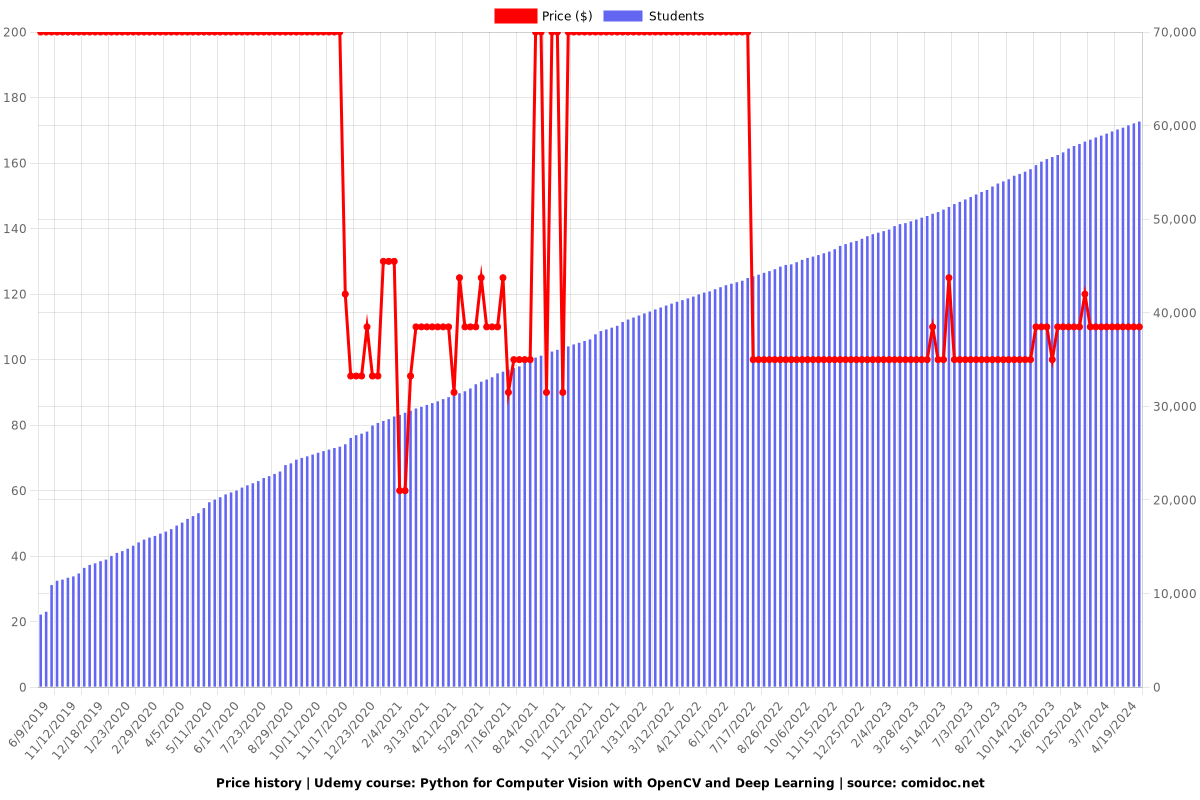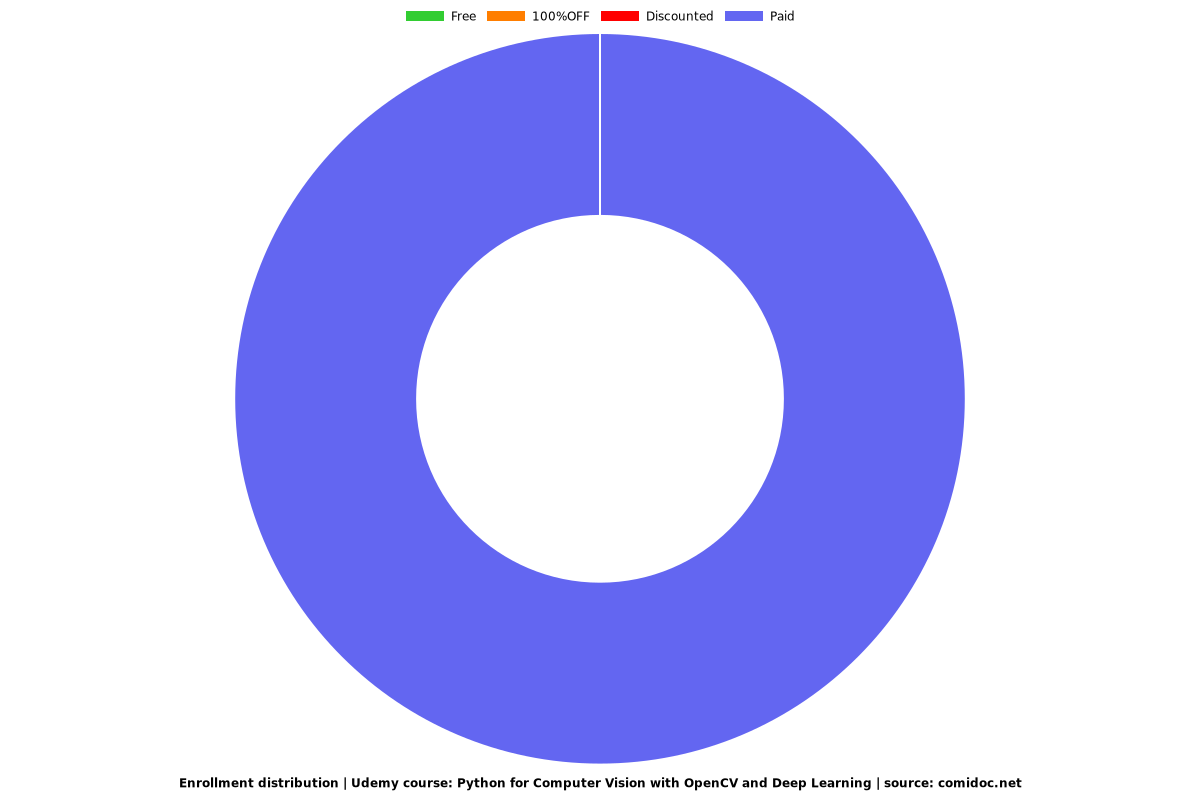Python for Computer Vision with OpenCV and Deep Learning
Learn the latest techniques in computer vision with Python , OpenCV , and Deep Learning!
4.60 (10794 reviews)

60,509
students
14 hours
content
Mar 2021
last update
$109.99
regular price
What you will learn
Understand basics of NumPy
Manipulate and open Images with NumPy
Use OpenCV to work with image files
Use Python and OpenCV to draw shapes on images and videos
Perform image manipulation with OpenCV, including smoothing, blurring, thresholding, and morphological operations.
Create Color Histograms with OpenCV
Open and Stream video with Python and OpenCV
Detect Objects, including corner, edge, and grid detection techniques with OpenCV and Python
Create Face Detection Software
Segment Images with the Watershed Algorithm
Track Objects in Video
Use Python and Deep Learning to build image classifiers
Work with Tensorflow, Keras, and Python to train on your own custom images.
Why take this course?
🚀 **Course Title:** Python for Computer Vision with OpenCV and Deep Learning 👨💻✨
**Headline:** 🌟 Learn the latest techniques in computer vision with Python, OpenCV, and Deep Learning!
---
### Course Description:
Embark on an exciting journey into the world of **Computer Vision** with our comprehensive online course tailored for aspiring developers and tech enthusiasts. This is your golden ticket to mastering the use of Python alongside the powerful OpenCV library, as well as delving into the cutting-edge field of Deep Learning, all within the realm of image and video data analysis.
📊 **Why Now?**
With the digital age in full swing, a staggering amount of visual content is being created every second - over 300 hours of video on YouTube alone! The demand for professionals skilled in computer vision is skyrocketing, making it one of the most lucrative and sought-after job markets. As Python continues its meteoric rise as the fastest-growing programming language, your investment in this course will position you at the forefront of a rapidly evolving industry.
🚀 **Course Highlights:**
- 🧮 **NumPy Fundamentals**: Get comfortable with numerical processing to lay a solid foundation for your computer vision projects.
- 📸 **Image Manipulation with NumPy**: Discover how to open, manipulate, and enhance images using the robust NumPy library.
- 👁️🗨️ **OpenCV Essentials**: Gain hands-on experience with OpenCV to process and analyze images and video data effectively.
- 🎥 **Video Processing Techniques**: Learn to work with streaming video, understand optical flow, and implement object detection including face recognition.
- 🧠 **Deep Learning Mastery**: Dive deep into the world of neural networks, image recognition, custom classifications, and state-of-the-art YOLO networks.
### Course Outline:
This course is packed with a rich curriculum designed to take you from novice to expert in computer vision. Here's a glimpse of what you'll cover:
- NumPy: Get started with the fundamental library for scientific computing in Python.
- Images with NumPy: Learn how to manipulate and enhance images using NumPy.
- Image and Video Basics with NumPy: Understand the core concepts of image processing.
- Color Mappings: Master color transformations to visualize data in new ways.
- Blending and Pasting Images: Combine images to create complex visual effects.
- Image Thresholding: Identify and process areas of interest within images.
- Blurring and Smoothing: Learn techniques to reduce noise and enhance details in images.
- Morphological Operators: Use morphology to find patterns or features in images.
- Gradients: Detect edges and lines, and understand the flow of pixel intensity across images.
- Histograms: Analyze the distribution of pixel intensities in images.
- Streaming Video with OpenCV: Work with video streams and real-time image processing.
- Object Detection: Detect objects, faces, and track them over time.
- Template Matching: Find templates or patterns within images.
- Corner, Edge, and Grid Detection: Identify structural elements in images for various applications.
- Contour Detection: Detect contours of objects in images.
- Feature Matching: Understand the process of finding corresponding points or features between two images.
- WaterShed Algorithm
- Face Detection: Recognize and track human faces within images or video data.
- Object Tracking: Follow objects over time in a sequence of images.
- Optical Flow (with OpenCV): Analyze the apparent motion of objects, scenes, or features between different frames of image data.
- Deep Learning with TensorFlow & Keras: Build neural networks for complex computer vision tasks.
- Convolutional Neural Networks (CNNs): Learn the architecture and use cases of CNNs in image classification and recognition.
- YOLO (You Only Look Once): Explore one of the most popular real-time object detection systems using deep learning.
Screenshots




Our review
---
**Overview of the Course:**
The course has received an overwhelmingly positive response from learners with a global rating of 4.64. The recent reviews highlight Jose Portilla's expertise as an instructor, with praise for his clear explanations and well-organized content. The course covers various aspects of Computer Vision and Deep Learning using OpenCV, and is appreciated for its practical approach and hands-on Python applications.
**Pros:**
- **Expert Instruction**: Jose Portilla is commended for his knowledgeable teaching style and precise explanations.
- **Comprehensive Coverage**: The course material is considered to be thorough and well-explained, making it easy to follow along.
- **Practical Application**: Learners appreciate the opportunity to work on practical projects, which are invaluable for real-world experience.
- **Organized Structure**: The course is noted for its logical progression and organization, allowing learners to navigate the material efficiently.
- **Solid Foundation**: For beginners, this course provides a solid understanding of the subject matter, especially for those coming from related fields like biostatistics.
- **Resourceful**: Additional resources provided are helpful for learners to deepen their knowledge and skills further.
- **Up-to-Date Content**: The majority of reviews praise the course's relevance and the inclusion of newer content where applicable.
**Cons:**
- **Environment Setup Issues**: There are recurring complaints about the difficulty in setting up the course environment, particularly for macOS users.
- **Outdated Resources**: Some learners have encountered deprecated functions within the course material.
- **Theoretical Gaps**: A few reviews suggest that while the course is practical, there could be more in-depth theoretical explanations.
- **Coding Confusion**: Some learners find the coding explanations unclear, especially later in the course, and suggest a more industry-standard approach to coding within JupyterLab.
- **Deep Learning Section**: The Deep Learning part of the course is considered less effective compared to the OpenCV content.
- **Lack of Real-World Data Types (e.g., Videos)**: Some learners express a desire for more complex data types, such as videos, in the Object Detection section.
**Recommendations:**
- **Update Environment Setup Instructions**: Ensure that the setup guide is comprehensive and updated, with clear troubleshooting steps for common issues.
- **Revise Outdated Content**: Regularly update the course material to include the latest versions of packages and software.
- **Enhance Theoretical Explanations**: Provide more detailed mathematical and theoretical backgrounds for each method covered in the course.
- **Improve Code Clarity**: Refine coding explanations to match real-world industry practices, particularly within JupyterLab environments.
- **Incorporate Additional Data Types**: Consider including various data types such as videos in practical exercises, especially in complex sections like Object Detection.
**Final Thoughts:**
Despite the few areas for improvement, this course stands out as an excellent introduction to Computer Vision and Deep Learning with OpenCV. It is a valuable resource for those looking to understand and apply these concepts in real-world scenarios. With some updates and enhancements, it could provide an even more comprehensive learning experience. Learners are encouraged to explore supplementary materials and potentially other courses to complement the knowledge gained from this course.
Charts
Price

Rating

Enrollment distribution

Related Topics
1982382
udemy ID
10/22/2018
course created date
6/9/2019
course indexed date
Bot
course submited by